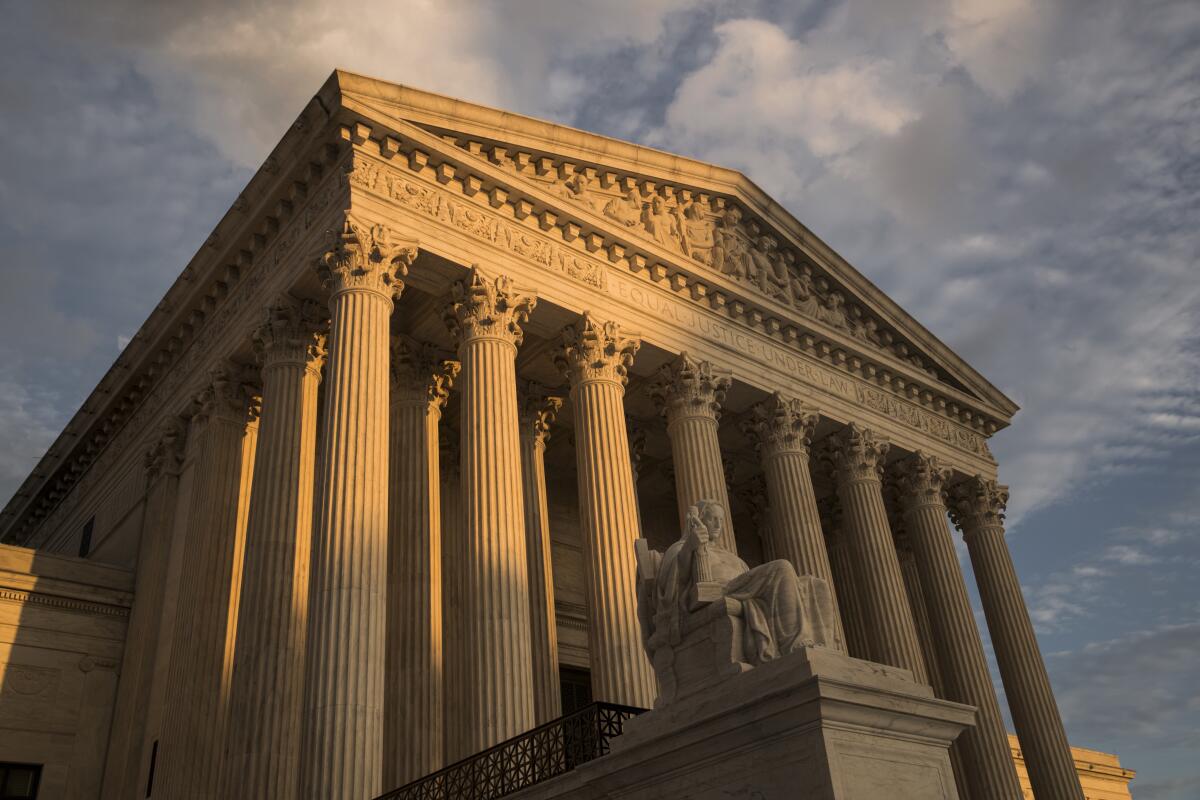Column: The Supreme Court debates the all-powerful F-word

- Share via
The F-word will soon be coming to the nation’s most august courtroom — again.
This time, it will get there courtesy of B.L., an anonymous young woman who wrote a profanity-filled Snapchat post after she was rejected for her high school’s varsity cheerleading team. Her post — and her school’s decision to punish her for it — has ignited a free speech case that will be argued before the U.S. Supreme Court next week.
But B.L. was not the first to focus the justices’ attention on the F-word. That distinction belongs to Paul Robert Cohen, whose case 50 years ago resulted in a landmark decision on the 1st Amendment and the regulation of profanity.
Cohen’s long legal saga began in Los Angeles on April 26, 1968, when he went to the county courthouse in downtown L.A. wearing a jacket that had the phrase “F— the draft” stenciled on the back (except that the word was fully spelled out).
Cohen, who was 19 at the time, says he was not trying to cause a confrontation. Nevertheless, he was promptly arrested for “maliciously and willfully disturb[ing] the peace or quiet ... by offensive conduct.” Rather than go to jail for 30 days, he challenged his conviction, fighting it all the way up through California courts and beyond. In the spring of 1971, his case reached the U.S. Supreme Court, where nine aging justices, all men, were called upon to decide whether the F-word was indeed “unprintable language” that could be banned by the government, despite the free speech protections of the Constitution.
It’s difficult to remember now just how seriously some people took profanity in those days. It often had been deemed punishable by law and was widely viewed as inherently offensive, especially to women and children.
Before oral arguments in Cohen vs. California, Chief Justice Warren Burger, a Nixon appointee, went to Cohen’s lawyer, Melville Nimmer, and asked him to not use the offending word in the courtroom. According to Thomas G. Krattenmaker, a clerk at the time for Justice John Marshall Harlan, Burger said he didn’t want anyone to “use that word” because it “would be the end of the court.”
But times were changing. In the late 1960s and early 1970s, a new generation was waging battles against its elders over moral restrictions on sex and squeamish attitudes toward profanity and obscenity, and many young people liked to say, justifiably, that the use of the F-word was hardly as offensive as the killing of civilians in Vietnam.
David Nimmer, the son of Cohen’s lawyer, told me: “I was 16 years old sitting in the Supreme Court gallery when my father ignored Chief Justice Burger’s admonition” and spoke the offending word before the justices.
It was a risky decision, but it did not bring down the walls of the courthouse after all.
Cohen was an unlikely free-speech champion. I tried and failed to reach him for this column, but he said in a 2016 interview with the Freedom Forum Institute that a woman he met the night before his arrest had stenciled the offending words on his jacket. “I wasn’t trying to make a political statement,” he said. He added, “I had a PhD in partying back in those days.” In explaining why he fought all the way to the Supreme Court, Cohen said that he simply didn’t want to serve the 30 days. He didn’t attend the oral argument at the Supreme Court.
In the end, a divided court ruled narrowly — 5 to 4 — in favor of Cohen. Justice Harry Blackmun, in a curmudgeonly dissent, said that the case was all about an “absurd and immature antic” and that “this court’s agonizing over First Amendment values seems misplaced and unnecessary.”
But the majority disagreed, and Justice Harlan wrote a strong pro-speech decision. The message on Cohen’s jacket wasn’t incitement to violence, Harlan wrote, because it didn’t constitute “fighting words” directed at a person. It wasn’t obscenity because it wasn’t erotic. The offending language wasn’t “thrust upon” people unwittingly, because they could simply avert their eyes. The court rejected the notion that the government could act as “guardian of the public morality” in excising “one particular scurrilous epithet from public discourse.”
And Cohen’s underlying message about the draft merited constitutional protection, despite the manner in which he chose to express it.
“While the particular four-letter word being litigated here is perhaps more distasteful than most others of its genre,” wrote Harlan, “it is nevertheless often true that one man’s vulgarity is another’s lyric.”
Today, half a century has passed and we’re still fighting over the F-word. This newspaper won’t use it spelled out except on the rarest of occasions. Society still imbues it with a certain ability to shock, to insult, to enrage. That’s why B.L., a Pennsylvania schoolgirl, is before the Supreme Court now, all these years later. The question in Mahanoy Area School District vs. B.L. is whether her school can punish her for what she said on Snapchat (“f— school f— softball f— cheer f— everything.”) even though she was not at school when she wrote and posted it.
Once again the justices will be forced to consider the word and its power, and the right of the authorities to police it.
This time the language wasn’t used to comment on a burning social issue. But isn’t it time we got over our squeamishness?
@Nick_Goldberg
More to Read
A cure for the common opinion
Get thought-provoking perspectives with our weekly newsletter.
You may occasionally receive promotional content from the Los Angeles Times.











